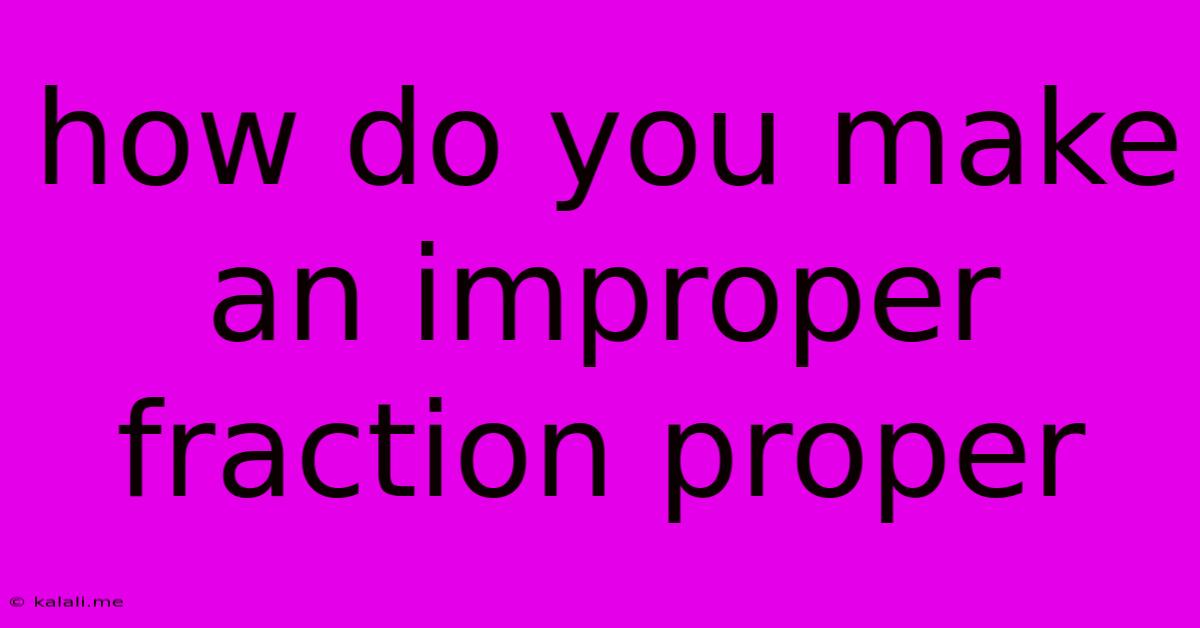How Do You Make An Improper Fraction Proper
Kalali
May 10, 2025 · 3 min read

Table of Contents
How to Make an Improper Fraction Proper: A Step-by-Step Guide
Converting an improper fraction to a mixed number is a fundamental skill in mathematics. An improper fraction is a fraction where the numerator (the top number) is greater than or equal to the denominator (the bottom number). This guide will walk you through the process clearly and concisely. Understanding this will help you confidently tackle more advanced math problems involving fractions.
Understanding Improper Fractions and Mixed Numbers
Before we dive into the conversion, let's clarify the terms. An improper fraction has a numerator larger than or equal to its denominator, for example, 7/4 or 5/5. A mixed number, on the other hand, combines a whole number and a proper fraction (a fraction where the numerator is smaller than the denominator), such as 1 ¾ or 2 ½.
The Conversion Process: Step-by-Step
Converting an improper fraction to a mixed number involves a simple division process. Here's how you do it:
-
Divide the numerator by the denominator: This is the core of the conversion. Perform the division and note both the quotient (the whole number result) and the remainder.
-
The quotient becomes the whole number part of your mixed number: This is the whole number that sits before the fraction in the mixed number.
-
The remainder becomes the numerator of the proper fraction: This is the top number of the fraction part of your mixed number.
-
The denominator remains the same: The denominator of your improper fraction stays the same in the proper fraction part of your mixed number.
Examples to Illustrate
Let's solidify this with some examples:
Example 1: Converting 7/4
-
Divide 7 by 4: 7 ÷ 4 = 1 with a remainder of 3.
-
The quotient (1) is the whole number.
-
The remainder (3) is the new numerator.
-
The denominator (4) remains the same.
Therefore, 7/4 as a mixed number is 1 ¾.
Example 2: Converting 11/5
-
Divide 11 by 5: 11 ÷ 5 = 2 with a remainder of 1.
-
The quotient (2) is the whole number.
-
The remainder (1) is the new numerator.
-
The denominator (5) remains the same.
Therefore, 11/5 as a mixed number is 2 ⅕.
Example 3: Converting 5/5
-
Divide 5 by 5: 5 ÷ 5 = 1 with a remainder of 0.
-
The quotient (1) is the whole number.
-
The remainder (0) means there's no fractional part.
Therefore, 5/5 as a mixed number is simply 1.
Simplifying Mixed Numbers
Sometimes, the fractional part of your mixed number can be simplified. For example, if you had converted a fraction and ended up with 2 ⁴⁄₈, you would simplify the fraction to 2 ½ by dividing both the numerator and denominator by 4. Always remember to simplify your fractions to their lowest terms for a complete answer.
Mastering Fraction Conversions
Understanding how to convert improper fractions to mixed numbers is crucial for success in algebra and beyond. Practice these steps with different improper fractions, and you'll quickly master this essential math skill. Remember, consistent practice is key to building proficiency in any mathematical concept.
Latest Posts
Latest Posts
-
How To Tell When Chorizo Is Done
Jul 02, 2025
-
Why Doesnt Christian Bale Remove His Mole
Jul 02, 2025
-
Somebody Once Told Me That The World Was Macaroni Lyrics
Jul 02, 2025
-
How Old Are You If Born In 1993
Jul 02, 2025
-
What Is 1 4 Of 1 4 Cup
Jul 02, 2025
Related Post
Thank you for visiting our website which covers about How Do You Make An Improper Fraction Proper . We hope the information provided has been useful to you. Feel free to contact us if you have any questions or need further assistance. See you next time and don't miss to bookmark.